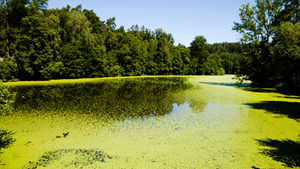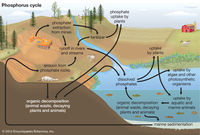Eutrophication: Difference between revisions
No edit summary |
No edit summary |
||
| Line 3: | Line 3: | ||
== Causes == | == Causes == | ||
While eutrophication is usually a natural process that takes place over the course of hundreds of years, it has in recent decades been negatively influenced and accelerated due to human influence. Naturally occurring eutrophication happens on geologic time scales, [3] but as mentioned, that is no longer the case in most places due to anthropogenic or cultural eutrophication. Cultural eutrophication occurs through either non-point source or point source pollution at the hands of humans. [2] Examples of point-source or non-point source pollution that increase the rates of eutrophication can include, detergents, fertilizers, and sewage which can come from anywhere whether it be parking lots and roads or agricultural fields. [3][4] The most problematic of these tends to be the fertilizers that | While eutrophication is usually a natural process that takes place over the course of hundreds of years, it has in recent decades been negatively influenced and accelerated due to human influence. Naturally occurring eutrophication happens on geologic time scales, [3] but as mentioned, that is no longer the case in most places due to anthropogenic or cultural eutrophication. Cultural eutrophication occurs through either non-point source or point source pollution at the hands of humans. [2] Examples of point-source or non-point source pollution that increase the rates of eutrophication can include, detergents, fertilizers, and sewage which can come from anywhere whether it be parking lots and roads or agricultural fields. [3][4] The most problematic of these tends to be the fertilizers that are used primarily with agricultural fields and grass lawns. Not to mention, clearing of land as well as the building of cities and towns leads to sediment runoff which worsens the rates that phosphates and nitrates make their way into bodies of water. [5] [[File:126077-050-117592F5.jpg|200px|thumb|right]] | ||
== Consequences == | == Consequences == | ||
| Line 16: | Line 16: | ||
4. Muir, P., 2012. Eutrophication [WWW Document]. Oregon State University. URL http://people.oregonstate.edu/~muirp/eutrophi.htm | 4. Muir, P., 2012. Eutrophication [WWW Document]. Oregon State University. URL http://people.oregonstate.edu/~muirp/eutrophi.htm | ||
5. Schindler, David W., Vallentyne, John R. (2008). The Algal Bowl: Overfertilization of the World's Freshwaters and Estuaries, University of Alberta Press, ISBN 0-88864-484-1. | |||
Revision as of 19:44, 5 May 2019
Definition
Eutrophication, sometimes known as hypertrophication, is the process by which a body of water becomes enriched in dissolved nutrients (such as phosphates) through the intense breakdown of soil sediments that stimulate the growth of aquatic plant life. This will usually lead to the depletion of dissolved oxygen which is known as hypoxia. [1] This phenomena is perfectly fine when it happens at normal rates, but not at the rates that we are currently witnessing.

Causes
While eutrophication is usually a natural process that takes place over the course of hundreds of years, it has in recent decades been negatively influenced and accelerated due to human influence. Naturally occurring eutrophication happens on geologic time scales, [3] but as mentioned, that is no longer the case in most places due to anthropogenic or cultural eutrophication. Cultural eutrophication occurs through either non-point source or point source pollution at the hands of humans. [2] Examples of point-source or non-point source pollution that increase the rates of eutrophication can include, detergents, fertilizers, and sewage which can come from anywhere whether it be parking lots and roads or agricultural fields. [3][4] The most problematic of these tends to be the fertilizers that are used primarily with agricultural fields and grass lawns. Not to mention, clearing of land as well as the building of cities and towns leads to sediment runoff which worsens the rates that phosphates and nitrates make their way into bodies of water. [5]

Consequences
Prevention & Reversal
References
1. Eutrophication. (n.d.). . Merriam-Webster. https://www.merriam-webster.com/dictionary/eutrophication.
2. Chislock, M. F., Doster, E., Zitomer, R. A. & Wilson, A. E. (2013) Eutrophication: Causes, Consequences, and Controls in Aquatic Ecosystems. Nature Education Knowledge 4(4):10
3. Callisto, Marcos; Molozzi, Joseline and Barbosa, José Lucena Etham (2014) "Eutrophication of Lakes" in A. A. Ansari, S. S. Gill (eds.), Eutrophication: Causes, Consequences and Control, Springer Science+Business Media Dordrecht. doi:10.1007/978-94-007-7814-6_5. ISBN 978-94-007-7814-6.
4. Muir, P., 2012. Eutrophication [WWW Document]. Oregon State University. URL http://people.oregonstate.edu/~muirp/eutrophi.htm
5. Schindler, David W., Vallentyne, John R. (2008). The Algal Bowl: Overfertilization of the World's Freshwaters and Estuaries, University of Alberta Press, ISBN 0-88864-484-1.